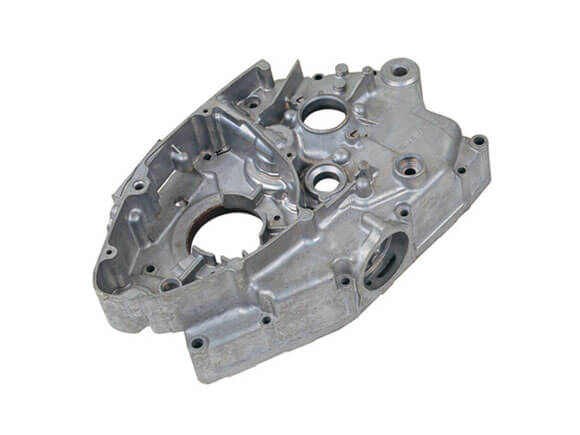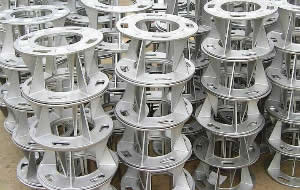Aluminum casting techniques that deliver lightweight components
Understanding the Ecological Benefits of Light Weight Aluminum Foundry Techniques
Aluminum factory methods play an important duty beforehand sustainability within the manufacturing market. By executing innovative reusing approaches and energy-efficient practices, these methods significantly minimize waste and carbon footprints. Ingenious casting methods further boost resource conservation initiatives. As industries increasingly focus on ecological duty, recognizing the full influence of these practices comes to be vital. What details improvements are leading the way in this transformation?
The Function of Light Weight Aluminum in Sustainable Manufacturing
Several products add to lasting production, light weight aluminum stands out due to its one-of-a-kind homes and recyclability. This light-weight steel is not only sturdy but also has superb rust resistance, making it an optimal selection for numerous applications, from automobile to construction. Its high strength-to-weight ratio leads to power cost savings during transport and use. In addition, aluminum can be recycled indefinitely without losing its inherent high qualities, promoting a circular economic situation.
The manufacturing procedure of aluminum has actually advanced, including energy-efficient methods that reduce carbon impacts. By using eco-friendly power resources, makers are significantly minimizing the ecological impact associated with aluminum production. Furthermore, using recycled light weight aluminum calls for substantially much less energy contrasted to removing and fine-tuning key light weight aluminum, leading to lower greenhouse gas exhausts. As markets seek lasting remedies, aluminum's versatility and green characteristics position it as a critical material in the pursuit of greener manufacturing methods.
Advanced Recycling Techniques in Aluminum Foundries
Advanced reusing techniques in aluminum factories are revolutionizing the method scrap aluminum is processed and reused. Cutting-edge techniques, such as closed-loop recycling systems, make it possible for shops to redeem aluminum from manufacturing waste and obsolete items efficiently. These systems decrease material loss and improve the top quality of recycled light weight aluminum, making it a practical alternative to primary light weight aluminum production.
In addition, progressed sorting modern technologies, consisting of automated optical sorting and X-ray fluorescence, boost the splitting up of aluminum from other materials, making sure greater purity levels in recycled outcomes. This accuracy minimizes contamination, which can endanger the stability of the last item.
The assimilation of innovative melting innovations, such as induction melting and energy-efficient heaters, enhances the reusing process, lowering power consumption. Jointly, these advancements add to a much more lasting light weight aluminum industry by reducing reliance on virgin materials and decreasing greenhouse gas discharges connected with aluminum manufacturing.
Power Performance Improvements in Factory Procedures
Energy effectiveness renovations in light weight aluminum foundry operations can significantly improve sustainability practices. Executing waste heat recovery systems enables shops to repurpose excess energy, decreasing general power intake. Additionally, developments in procedure automation improve operations, resulting in minimized waste and optimized resource usage.
Waste Warmth Healing
Applying waste heat recuperation systems in light weight aluminum factories considerably boosts energy effectiveness by recording and recycling excess thermal energy generated during manufacturing processes. These systems promote the conversion of wasted warm right into usable power, which can be used for different applications within the shop, such as pre-heating products or powering equipment. By recovering warmth that would otherwise be removed into the setting, foundries can considerably reduce their general energy intake and greenhouse gas exhausts. This technique not only reduces operational costs yet also advertises lasting methods within the market. In addition, the adoption of waste warm recovery technologies lines up with regulatory standards aimed at minimizing ecological effect, making it an important part of modern-day aluminum shop procedures.
Process Automation Perks
Automating processes in light weight aluminum foundries can substantially boost power efficiency by maximizing production workflows and reducing waste. By executing innovative modern technologies such as robotics and maker discovering, foundries can enhance procedures, minimizing unneeded power intake. Automated systems promote specific control over temperature level and product handling, ensuring that energy is utilized only when required. In addition, real-time tracking enables instant modifications, reducing the danger of power loss. The integration of automation not just enhances efficiency however likewise decreases functional expenses, making factories more affordable. Therefore, these energy-efficient practices contribute significantly to sustainability goals, minimizing the ecological impact of light weight aluminum manufacturing while meeting enhancing market needs - aluminum casting. Boosted energy efficiency with automation stands for an essential action towards greener shop operations
Lowering Waste With Innovative Casting Techniques
Innovative casting approaches play a vital role in lowering waste in aluminum shops. Methods such as sophisticated molding and the use of recyclable products substantially decrease manufacturing scrap. These practices not just improve performance but likewise add to an extra lasting production process.
Advanced Molding Techniques
As markets progressively prioritize sustainability, advanced molding techniques in aluminum factories emerge as effective services for lowering waste. These innovative techniques, such as 3D printing and accuracy mold production, significantly improve the performance of the casting procedure. By using computer-aided style (CAD) and simulation innovations, suppliers can optimize mold and mildew geometry, lessening product usage while maintaining item integrity. Additionally, progressed techniques enable the manufacturing of complicated shapes that traditional methods can not achieve, decreasing the requirement for added machining and therefore decreasing scrap material. The flexibility of these strategies enables rapid prototyping, further lowering preparations and power usage. Generally, the execution of sophisticated molding strategies represents a vital action toward environmentally accountable aluminum production, lining up with worldwide sustainability objectives.
Recyclable Product Application
Recyclable products play an essential function in lowering waste within aluminum shops, changing the spreading landscape with their efficient use. By integrating scrap aluminum and other recyclable components into the manufacturing procedure, foundries can considerably decrease the need for virgin products. This not only preserves natural deposits but additionally decreases power consumption associated with mining and refining. Innovative casting approaches, such as die casting and sand casting, allow for smooth combination of these products, making sure top notch outcomes. Furthermore, using recyclable materials fosters a see this here circular economy, where sources are continually reused and repurposed, reducing landfill payments. Inevitably, the critical usage of recyclables boosts sustainability while promoting cost-effectiveness in light weight aluminum foundry procedures.
Minimizing Production Scrap

Life Cycle Assessment of Light Weight Aluminum Products
Aluminum is commonly recognized for its light-weight and resilient properties, a comprehensive Life Cycle Evaluation (LCA) discloses the environmental effects linked with its use, production, and disposal. The LCA process takes a look at the power intake, greenhouse gas emissions, and source exhaustion linked to aluminum products from removal of bauxite ore to end-of-life management. Main light weight aluminum production is energy-intensive, typically relying upon nonrenewable fuel sources, which adds considerably to carbon impacts. On the other hand, recycling light weight aluminum uses substantial environmental benefits, as it utilizes just a portion of the energy required for main manufacturing. Additionally, the reusing process decreases land fill waste and saves all-natural resources. The LCA also considers the product's long life and possibility for reuse, emphasizing the value of sustainable design. In general, recognizing the life process impacts of aluminum products is essential for making educated choices that focus on ecological sustainability within the sector.
Case Studies: Effective Sustainable Practices in the Industry
The light weight aluminum industry has actually begun to embrace innovative lasting practices that resolve the environmental difficulties identified in Life Cycle Analyses. One significant situation is a leading shop that applied a closed-loop recycling system, substantially minimizing waste and energy consumption. By reusing scrap aluminum in manufacturing, the facility achieved a 40% decrease in its carbon impact.
One more instance includes a maker that embraced renewable power sources, powering its operations with solar and wind power - Precision aluminum casting. This shift not only reduced greenhouse gas emissions however also boosted the company's track record among eco conscious customers
Additionally, a third factory has bought advanced spreading strategies, which optimize product use and lessen issues, further lowering resource usage. These study illustrate that the light weight aluminum sector can integrating lasting practices, showing both ecological obligation and economic viability, eventually adding to a much more lasting future.
Frequently Asked Concerns
Exactly How Does Aluminum Contrast to Various Other Metals in Sustainability?
Aluminum is normally thought about more sustainable than many metals as a result of its recyclability, lower power needs for production, and minimized environmental influence. Its lifecycle performance surpasses that of steel and copper in numerous applications.
What Is the Carbon Impact of Aluminum Foundry Processes?
The carbon footprint of aluminum foundry processes differs, usually varying from 4 to 15 statistics bunches of carbon dioxide per heap of light weight aluminum generated. Factors affecting this consist of power sources, innovation, and the effectiveness of procedures.
Are There Wellness Risks Related To Light Weight Aluminum Factory Procedures?

What Are the Expenses Related To Lasting Light Weight Aluminum Techniques?
The expenses associated with lasting light weight aluminum methods include greater preliminary investments in technology, potential rises in operational expenses, and ongoing maintenance. Nonetheless, these are typically countered by long-term financial savings and reduced environmental influence.
Just How Does Light Weight Aluminum Recycling Influence Local Communities?
Aluminum recycling positively impacts neighborhood communities by producing tasks, decreasing garbage dump waste, and reducing energy costs. It promotes economic check these guys out growth and advertises environmental stewardship, bring about much healthier living problems and improved neighborhood interaction in sustainability efforts.
Furthermore, the use of recycled aluminum requires substantially less power compared to extracting and improving key light weight aluminum, leading to reduced greenhouse gas exhausts. Advanced reusing strategies in aluminum foundries are transforming the way scrap aluminum is processed and recycled. Aluminum Foundry. Implementing waste heat healing systems in aluminum factories significantly boosts find more info energy efficiency by recording and reusing excess thermal energy produced during manufacturing procedures. Automating processes in light weight aluminum foundries can greatly improve energy performance by optimizing production operations and minimizing waste. The carbon footprint of light weight aluminum shop procedures varies, normally ranging from 4 to 15 statistics heaps of CO2 per bunch of aluminum generated